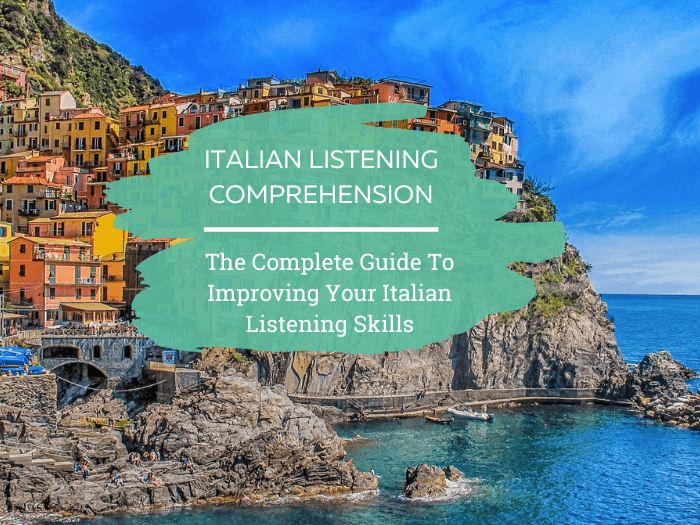Today I'm delighted to feature a guest post by Gloria Spagnoli formerly of Speakita.com about how to master your Italian listening skills.
It's no secret that improving your listening comprehension skills is one of the keys to fluency.
But how can you actually do it? Especially in Italian where native speakers seem to talk so fast!
Gloria has some answers for you.
By the way, my top recommendation to improve Italian listening comprehension is Conversations. It's an exciting story-based course that helps you understand real Italian and transform your listening skills in 90 days or less. Check it out.
Anyway, over to Gloria…
How many times has this happened to you when learning Italian? You dedicate months of your time to studying the language, going through word lists, verb conjugations, and fill-in-the-blank exercises…
You then decide that you want to do some Italian listening practice. You’ve been studying for a while, after all. You’re sure it’s going to be alright.
You choose a random podcast, TV show, YouTube video… expecting to catch at least the words that you know. But disappointment immediately hits you. Words run too fast. They mix and mingle and you can barely catch them.
It's frustrating, isn't it? “Why is listening to Italian conversations so hard? Is it just me?”
The good news is, that it's not just you. Even better, you can take steps to improve your Italian listening comprehension skills so you can understand fast-talking native Italian speakers.
Here's what you'll discover thanks to this post:
Table of Contents
So let's get into it.
Why Italian Listening Comprehension Is Hard

There are a couple of reasons why episodes like the one I described above may occur:
- You’re starting out. It might sound banal to say, but when you begin to train a new skill, like listening, you need time to see your first results. We’re not used to being ok with being uncomfortable, but we have to accept and embrace a little bit of uncomfortableness in our lives. This is crucial if we want to grow as learners.
- You might have chosen the wrong track for you. Maybe something with too many unfamiliar words. Or something too fast for you at your current stage. Before you drown yourself in the sea of failure, try and consider this option as well.
You see, most of the time “it’s not your fault”. I’m saying this because we, as human beings, are often tempted to blame ourselves when we don’t reach the results that we want.
But sometimes it’s a matter of looking at the circumstances and analyzing them from a neutral perspective. You will see that it is nobody’s fault. It’s all a matter of time, patience, and finding the right resources to help you flourish.
Now, since I am a firm believer that there’s a solution for every problem, let’s see the most common problems you might face when listening to an Italian conversation. And then let’s see how to address them and make them a memory of the past.
Italian People Speak Too Fast

This is absolutely normal. When people speak in their first language, they overlap, cut words, interrupt each other, and change topics… all of this in a fraction of a second.
If you’re not used to it, it feels like a minestrone of sounds. And, coming from the country of minestrone, Italian is no exception. Besides, we’re famous for speaking fast, cutting words (or “eating words”, as we say), and overlapping and interrupting each other. We can’t help it.
And we don’t do it to be rude. It’s just our way to show interest. This, however, doesn’t mean that you will never be able to understand when you listen to Italian conversations. It’s all a matter of training yourself to understand what is going on. I'll talk about it later in this post.
I Can’t Recognise Words In Fast Italian Speech

You open your online dictionary, look for your word, and listen to its pronunciation. Everything sounds clear. Then, when you’re in the middle of a conversation and that same word pops up… you barely understand it. How come?
In Italian speech, words blend together. Especially when they begin or end with a vowel.
Dove vuoi andare?
As you can see, vuoi comes right after dove, with no breaks in between. And we have blended the -i at the end of vuoi with the -a at the beginning of andare.

This is what you can expect when listening to Italian.
And, of course, you need to take intonation into account. Each language comes with a different intonation, and becoming familiar with it will help you detect and recognize words more clearly. I'm going to talk about intonation later on in this blog post.
How To Get Italian Listening Comprehension Practice

We saw the initial struggles when first trying to understand Italian conversations. Now it’s time to see what you can do to address them and change the situation in your favour.
As simplistic as it sounds, you can begin by training yourself at home. Here are a few steps that you can follow to prepare yourself independently to do Italian listening comprehension practice.
1. Choose A Quiet Space
Choose a spot where no one can disturb you. Use your headphones or earphones, to make sure the sound comes clear to your ears. Take a few deep breaths and relax. Take this time to focus only on what you’re about to listen to.
Sometimes, we have a lot of expectations about what is about to come. This time, try and stay curious about it. See what really comes.
2. Leave Your Self-Talk Out
You know those little voices telling you that you’re not going to understand anything? That you’d better give up and do something else? That you’re not as good as other people?
There’s no room for them right now. But don’t push them away, or they will come back stronger than before. Instead, tell them: “thank you, but I don’t need you right now.”. Move your focus from your thoughts to the present moment. To what is really happening right now. And not to what might happen in your worst-case scenario.
3. Choose The Right Italian Listening Resources For You
Pick a track that is understandable enough but challenging enough, like one of these 9 Italian podcasts. Ideally, you should be able to understand 70% or 75% of it.
Also, pay attention to the speed. Look for Italian listening comprehension exercises that aren't too slow, or too fast for you. You want to be challenged and motivated. Not bored to death or frustrated.
4. Listen With The Transcript
Your audio track should come with a transcript. When you’re starting out, it’s important to have a written reference of what you hear. It helps you identify words more precisely and recognize them when you hear them. And being aware of what you know gives you more and more confidence in your abilities.
4-Step Italian Listening Comprehension Practice Process
Here is a simple, yet powerful exercise to train your ears with your audio track and its transcript:
- Listen to the audio track a couple of times. Simply focus on what you hear, without doing anything else.
- Play the track again and start writing what you hear. Feel free to stop and replay as many times as you want and need.
- Compare your transcription with the actual transcription. When you find differences between the two versions, simply acknowledge them without judging them as a “disaster” or a “proof of your failure”.
- Play the audio track again while you read the original transcript. Mark the parts that you find hard to understand and intentionally draw your attention to them.
When you draw your attention to something, remember to do it with a calm mind. Observe with curiosity, without anticipation or judgment, and without the assumption that you will never understand anyway.
Now it’s time to become familiar with the Italian sounds and intonation. As I said before, knowing what you might come across can really play a big role in your confidence level. So, let’s have a close look at Italian intonation and its unique phonetic phenomena.
How To Master Italian Intonation

Sometimes, intonation is even more important than Italian pronunciation. If you want to understand and be understood, you need to recognise and be recognized. And in order to do that, you need to know the identification mark of your group of people: intonation.
When it comes to Italian intonation, there are three important areas to focus on:
- Affirmative sentences
- Questions
- Sentence stress
When it comes to affirmative sentences, the intonation goes progressively from the top to the bottom.
Like in this sentence:
Mangiamo qualcosa.
The intensity of this sentence goes progressively from top to bottom.

On the other hand, when you hear a question, you will notice that the intonation goes from the bottom to the top. Like in this example:
Mangiamo qualcosa?

As for sentence stress, there is no specific rule for that. What it takes is full attention and some good practice. Here you have a few sentences to help you understand where the stress falls in an Italian sentence.
Dove vuoi andare?
Ho cambiato lavoro.
Vieni a cena da me!
When you have an audio track and its transcription, you can mark the letters where you hear the stress falling. This way, little by little, you will get more and more familiar with Italian sentence stress, and you will be able to detect it and replicate it in the future.
Blended Italian Sounds

It’s something so typical, yet so frustrating when you don’t know what it is about. You hear one big unclear sound and you have no clue of what it is. It might be one word, but you’re not quite sure about it.
The thing is that in Italian sounds tend to blend. Especially when words begin or end with a vowel. Let’s have a look at a few examples to have a better idea of what this phenomenon sounds like.
1. Quanti anni hai?

In this example, we have blended the -i at the end of Quanti with the -a at the beginning of anni. And the -i at the end of anni with the -a inside of hai. We skipped the h because, as we’re going to see later in this post, in Italian the h is silent.
2. Dove andiamo?

In this sentence, we have simply blended the -e at the end of Dove with the -a at the beginning of andiamo.
3. Devo andare a lavorare.

Finally, in this sentence, we have blended the -o at the end of Dove with the -a at the beginning of andare. And we have blended the -e at the end of andare with the preposition “a”.
As you can see, it’s a common trait of the Italian spoken language. Although it might sound and feel hard at first, with a little bit of attention you can learn how to discriminate between the different words inside of the big minestrone.
The C Sound
The consonant “c” can be either soft or hard. When the “c” is followed by the vowels “e” and “i”, then the sound will be a soft sound. Like in these examples:
Soft C sound
- Ciao
- Cento
- Cinema
- Noce
When, on the other hand, the consonant “c” is followed by the vowels “a”, “o”, and “u”, its sound will be a hard sound. Like in these examples.
Hard C sound
- Canzone
- Colore
- Cuore
Finally, when the consonant “c” is followed by an “h” + the vowel “e” or the vowel “i”, its sound will be a hard sound. Like in these examples.
Hard C with H
- Chitarra
- Anche
- Chiesa
- Amiche
The G Sound
Just like the C sound, the G sound can be either soft or hard. When the consonant “g” is followed by the vowels “i” or “e”, its sound will be a soft sound. Have a look at these words.
Soft G sound
- Gelato
- Gioco
- Gente
- Grigio
Then, when the consonant “g” is followed by the vowels “a”, “o”, or “u”, it will be pronounced with a hard sound. Just like in the following words.
Hard G sound
- Gatto
- Gomito
- Guanto
Finally, when the consonant “g” is followed by an “h” + the vowel “e” or the vowel “i”, it will be pronounced with a hard sound.
Hard G with H, “e” or “i”
- Ghiaccio
- Tartarughe
- Funghi
- Margherita
The H Sound
As I said before in this blog post, in Italian the “h” is silent. We saw that it changes how the consonants “c” and “g” are pronounced, but there are moments where the “h” is found at the beginning of a word.
Words like these are clearly not Italian, and the most common ones are:
The H sound
- Hotel
- Hobby
- Habitat
As you can see, although there is an “h” at the beginning of these words, we pronounce them as if they began with a vowel.
The GL Sound
This is one of the trickiest sounds, but I believe it is actually a fun one to learn. In order to pronounce the GL sound, you need to position the tip of your tongue on your palate. The result will be a sound like this one.
The GL sound
- Aglio
- Moglie
- Figlio
The Italian R sound
Italians are famous for their “r”. We are “r” rollers, and we’re often made fun of for that. Let’s have a look at how to pronounce it. How can you roll your “r”?
Position your tongue strategically. It should get close to your upper teeth without touching them. Leave your tongue suspended while keeping it close to your teeth. Then let the air come out while you pronounce your “r”. The result will be like this.
The R sound
- Roma
- Rosso
- Riso
- Parco
Double Consonants
Another challenge people face when trying to understand Italians is detecting double consonants. They are pretty unique, but they’re actually quite easy to detect and pronounce. All you need to do is mark the consonant and make it sound stronger. Like in these examples.
Italian double consonants
- Risotto
- Bellissimo
- Pasticcio
- Arrivo
- Oggetto
- Pacco
Bonus Italian Listening Comprehension Exercise

All the tips that we saw before can really help you improve your listening and start to understand Italian conversations.
However, there is one extra tip that will help you feel really a part of your conversations. Like you truly belong. Without that unpleasant feeling of being left behind: Replicate the sounds that you hear.
Draw your attention to them and listen to them carefully, while staying in the present moment. After that, repeat them out loud.
Once you know how to produce a sound, you will know how to detect it when you hear it. So allow your ears and mouth to get used to it and make it yours. You will see that it will be easier to catch it the next time that you hear it during a conversation in Italian.
Italian Listening FAQ
Can you learn Italian by listening?
Yes, listening is an effective way to learn Italian, especially for improving pronunciation and comprehension. By exposing yourself to Italian podcasts, audiobooks, or TV shows, you can pick up vocabulary, phrases, and sentence structures naturally. Pair listening with speaking and other active learning methods for best results.
What is the musicality of Italian language?
Italian is often called the “language of music” due to its rhythmic flow and melodic intonation. Its clear vowel sounds, regular stress patterns, and open syllables make it pleasing to the ear and easy to enunciate, which is why it is widely used in opera and classical music.
How do I learn conversational Italian?
To learn conversational Italian, focus on practical phrases, vocabulary, and speaking practice. Engage in daily conversations, listen to native speakers, and practise speaking with language partners or tutors. A course like Italian Conversations can also help.
How common is Italian spoken?
Italian is spoken by about 85 million people worldwide, including 67 million native speakers. While primarily spoken in Italy, it is also used in Switzerland, San Marino, the Vatican City, and communities in countries like the United States, Canada, Argentina, and Australia.
Italian Listening Comprehension Made Easy
So there you have it – everything you need to know about Italian listening comprehension to make it easier for you to understand and pronounce Italian.
What can you do next then? Well, bookmark this post and come back to it. As per the bonus tip, practise pronouncing Italian words yourself, until you feel comfortable saying them.
And the, the fun part, use the 4-part ear training process I described earlier in the post to practise Italian listening comprehension with the material you want to use. Depending on your level, that could be Italian movies , Italian TV shows, or Italian podcasts.
You'll be able to understand fast-talking Italians in no time!
About the author: Gloria blended mindfulness and language acquisition to help overwhelmed, self-taught Italian lovers find their Italian voice, speak with confidence, and feel empowered when engaging with Italians.

Olly Richards
Creator of the StoryLearning® Method
Olly Richards is a renowned polyglot and language learning expert with over 15 years of experience teaching millions through his innovative StoryLearning® method. He is the creator of StoryLearning, one of the world's largest language learning blogs with 500,000+ monthly readers.
Olly has authored 30+ language learning books and courses, including the bestselling "Short Stories" series published by Teach Yourself.
When not developing new teaching methods, Richards practices what he preaches—he speaks 8 languages fluently and continues learning new ones through his own methodology.










































